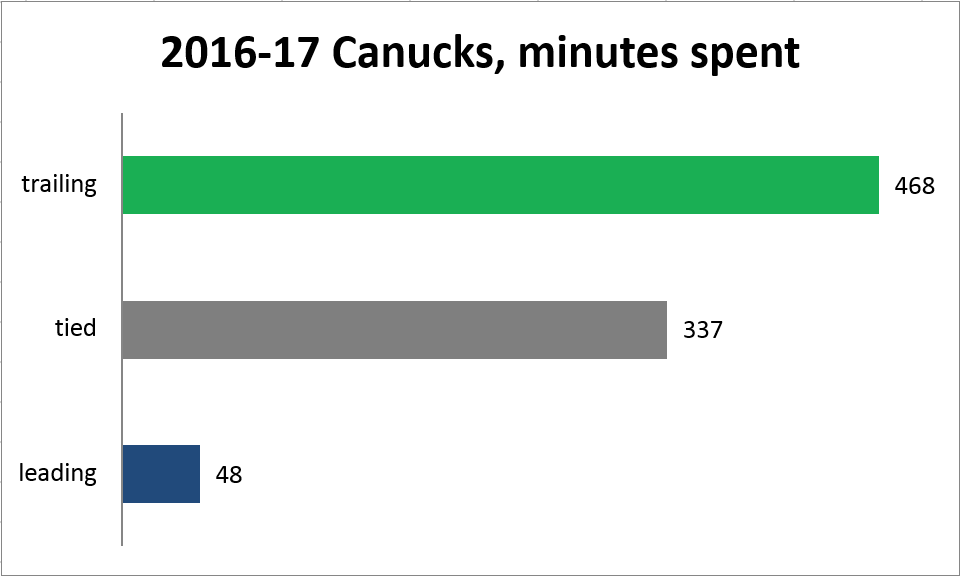According to the standings, the Vancouver Canucks are just one point away from last place in the NHL.
If we allow for games played, that thin margin disappears, with the Canucks tied with the Calgary Flames for the worst record in the league (5-8-1).
At a minimum, this is a team in need of restoration. If that fails, a full-blown rebuild will be required.
Right now things are ugly, and it isn’t just that the Canucks are losing contests. They’re behind early and often in games. Incredibly, Vancouver has spent nearly 10 minutes trailing the opposition for every minute they’ve had the lead.

At first glance, the team’s Corsi (a plus/minus of all shot attempts at 5-on-5, showing which team is controlling the puck) might seem like a ray of hope, as it’s just a bit south of 50 per cent.
The trouble is that trailing teams tend to shoot more. Adjust for score effects, and the Canucks are the worst Corsi team in the league, which reinforces the idea that they bought and paid for their current position in the NHL standings.
The big caveat in all this is that we’re only talking about 14 games — even if those games do come on the heels of a wretched performance in 2014-15.
There’s still time for general manager Jim Benning to make changes to his roster. Head coach Willie Desjardins may be vulnerable as well, though it’s highly debatable as to whether he’s a victim or a perpetrator in all of this.
Where things get really interesting is if whatever adjustments Benning makes fail to resurrect the team. If that happens, it will be hard to escape the idea that the time for half-measures and gentle retooling is over.
A team that spends two consecutive years in the cellar and fails to respond to management’s prodding is essentially already in a rebuild whether it’s marketed that way or not.
The first step in this hypothetical scenario is Darwinian: identifying which players will be able to really help when the team gets good again.
Understanding the time frame in all this is important.
The Chicago Blackhawks, Los Angeles Kings and Pittsburgh Penguins all had five-year spans between the time they started drafting in the top 10 every year and the moment when they finally won a playoff series. In the first two cases, that was despite the fact that a lot of key foundation players—Duncan Keith, Brent Seabrook, Corey Crawford, Anze Kopitar, Dustin Brown, Jonathan Quick—were already in the system. In the latter case, it was despite being gifted Sidney Crosby and Evgeni Malkin.
If we start the clock last summer with the drafting of Olli Juolevi with the fifth overall pick, that gives us a span of four years (ending in 2020) before we can realistically expect a truly competitive Canucks team. Any Vancouver player whose age precludes him from being an important piece of the team at that point is thus expendable.
We can also look with indifference at anyone who doesn’t meet the “Lee Stempniak threshold.” Stempniak has always been a perfectly capable middle-six winger and the living embodiment of the fact that such players are available every year in free agency for nothing but money — and less of that than one might expect.
If a young player can’t realistically be projected to be a better NHL player than Stempniak, there isn’t much point in worrying about how they slot into the rebuild. They can always be replaced.
Applying those two filters to the team’s current system clarifies things nicely.
The 2020 rule eliminates the 2011 core, including cornerstone pieces like the Sedins and Alex Edler. It also looks unfavourably on Benning’s additions like Loui Eriksson and Ryan Miller.
The Stempniak rule knocks out much of the remainder. Sven Baertschi and Markus Granlund are both debatable, but with each rapidly approaching age 25 and neither established as a top-six forward, it’s hard to project either as having a Stempniak-plus career with any level of certainty.
There are, however, some fascinating building blocks that remain after we eliminate all those players.
Bo Horvat is only 21. He’s already being trusted with heavy defensive responsibility, and he’s also coming off a 40-point campaign.
Other forwards that stand out include prospect Brock Boeser and young pros Jake Virtanen and Brendan Gaunce, though the latter two need to show more offence.
Some would include Brandon Sutter, but he’s already 27 and likely best suited to a third line role at even-strength, so it’s hard to see him leading the charge in 2020.
Defensively, Chris Tanev is only 26. Over the last three years, he’s played some brutal defensive minutes. When he’s been on the ice at 5-on-5, Vancouver has a 51 per cent Corsi rating and is exactly even in the goals department (plus-114/minus-114). When he’s been off the ice, the Canucks’ Corsi falls two points and they’re 22 goals below even. He’s improving the team while playing tough minutes, and is thus a key building block.
We can add Juolevi’s name to our list of keepers, and probably that of Ben Hutton as well. Hutton is just 23 and appears to be a legitimate top-four defenceman, though he doesn’t have Tanev’s longer track record.
Erik Gudbranson has a similar record to Tanev in playing tough minutes, but not the same run of driving results.
And it’s still far too early to include impressive rookie Troy Stecher on this kind of list.
In net, Markstrom is big, young and capable. Thatcher Demko’s pro career is off to a rough start, but he’s universally identified as a top goaltending prospect, so the team should be set in net for the foreseeable future.
If a full-scale rebuild becomes necessary, those are the players that Vancouver’s management should be building around.
While that decision is being made, it would probably be best to exclude those players from trade discussions aimed at a more immediate turnaround.
Just in case.








